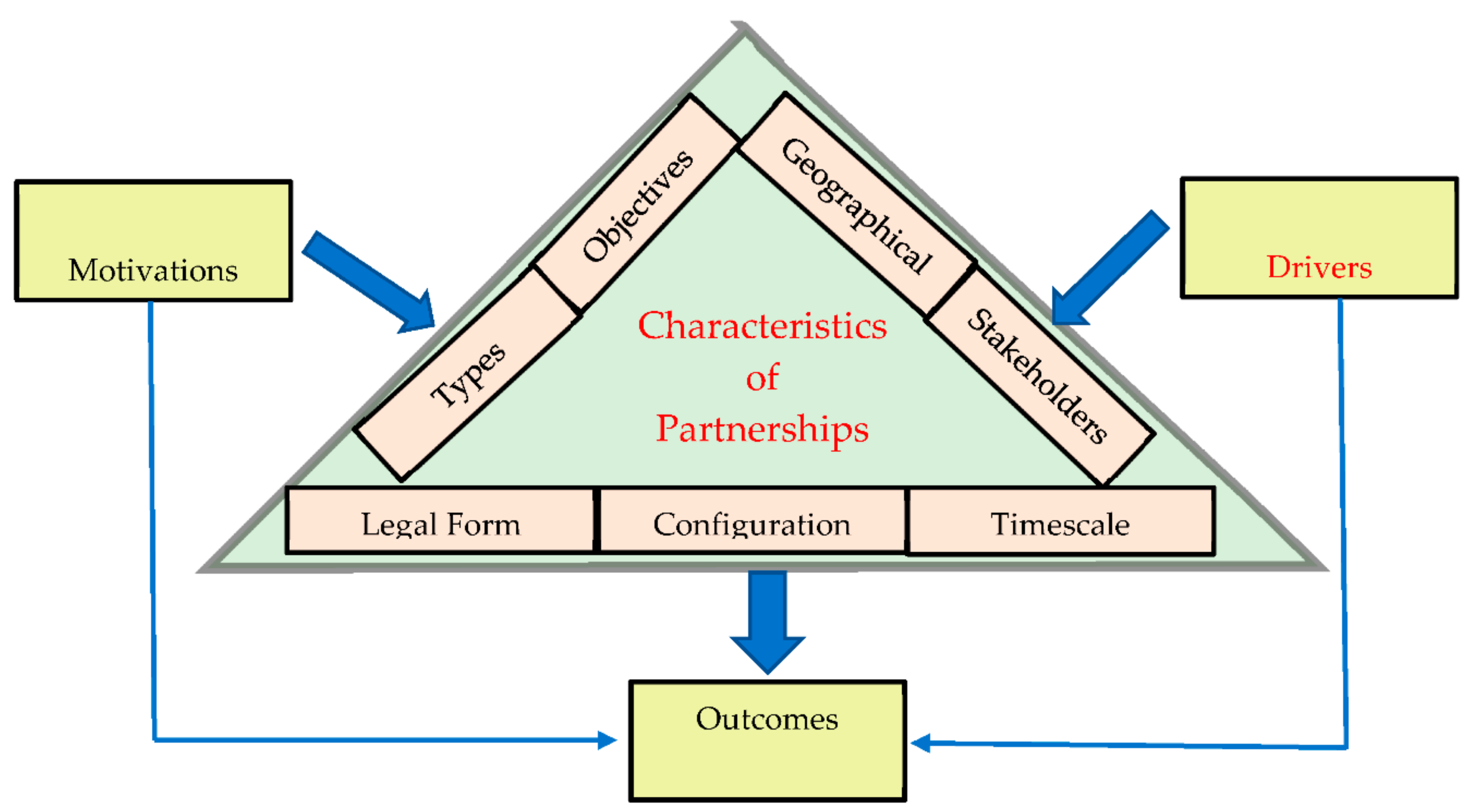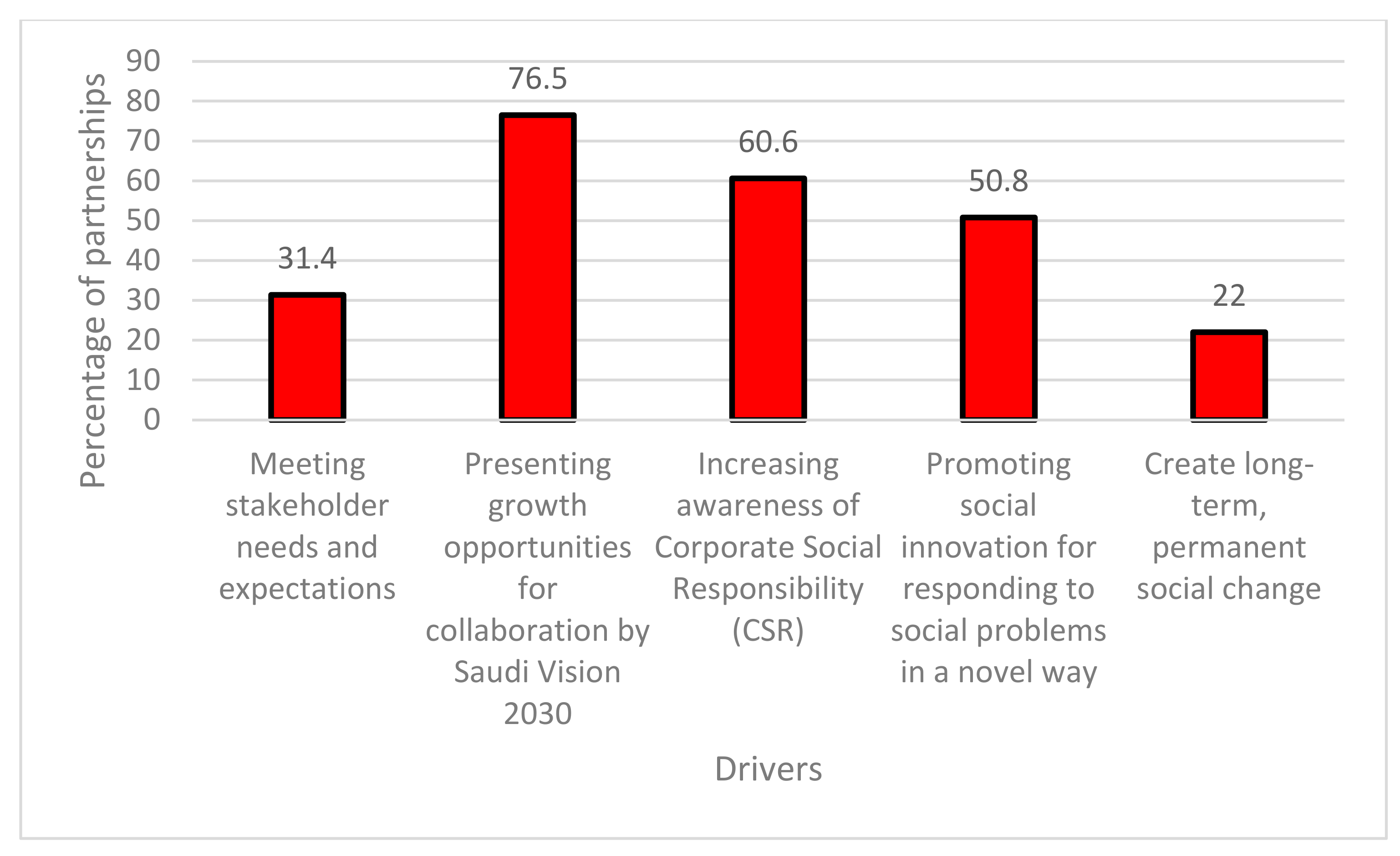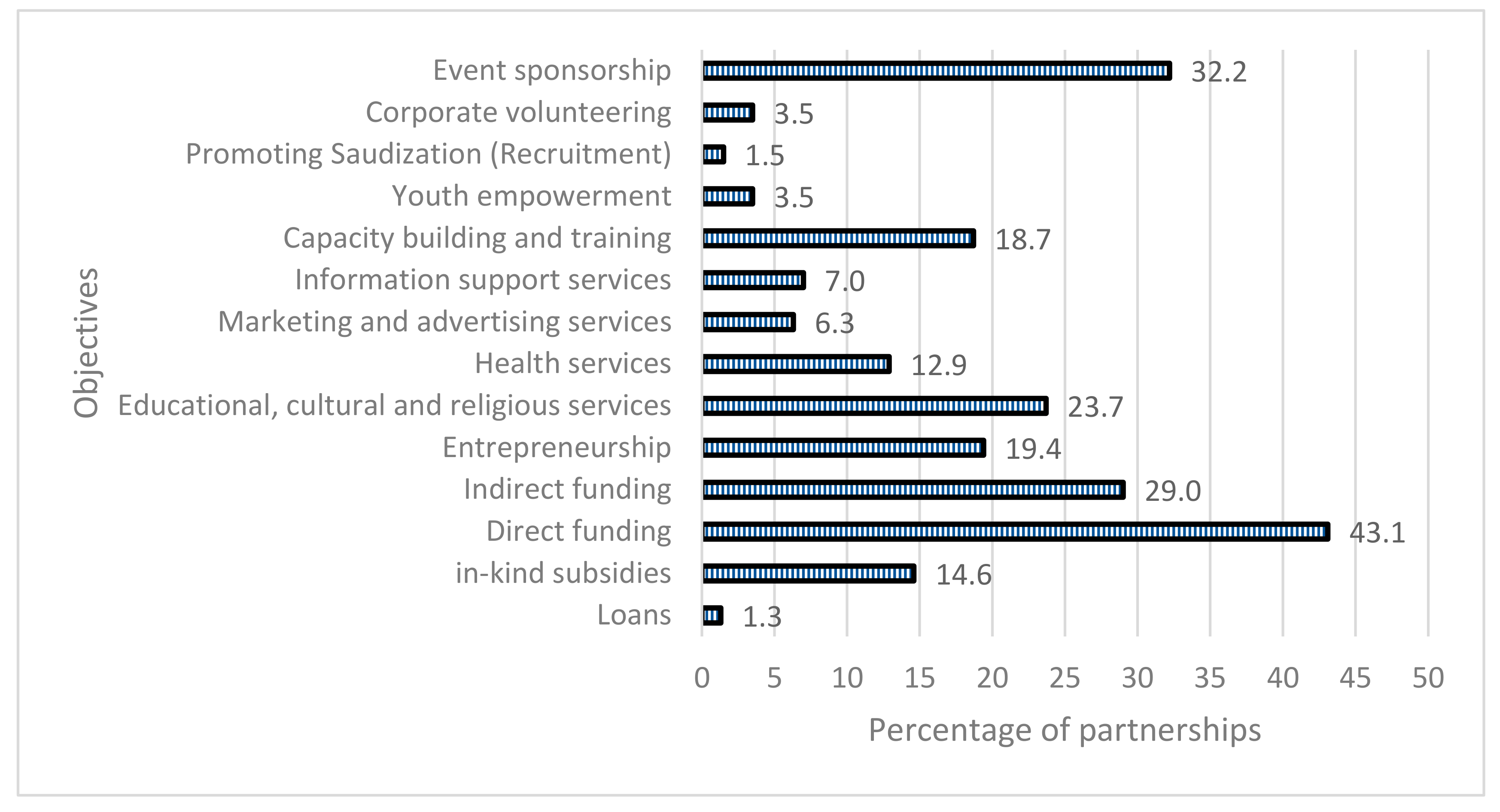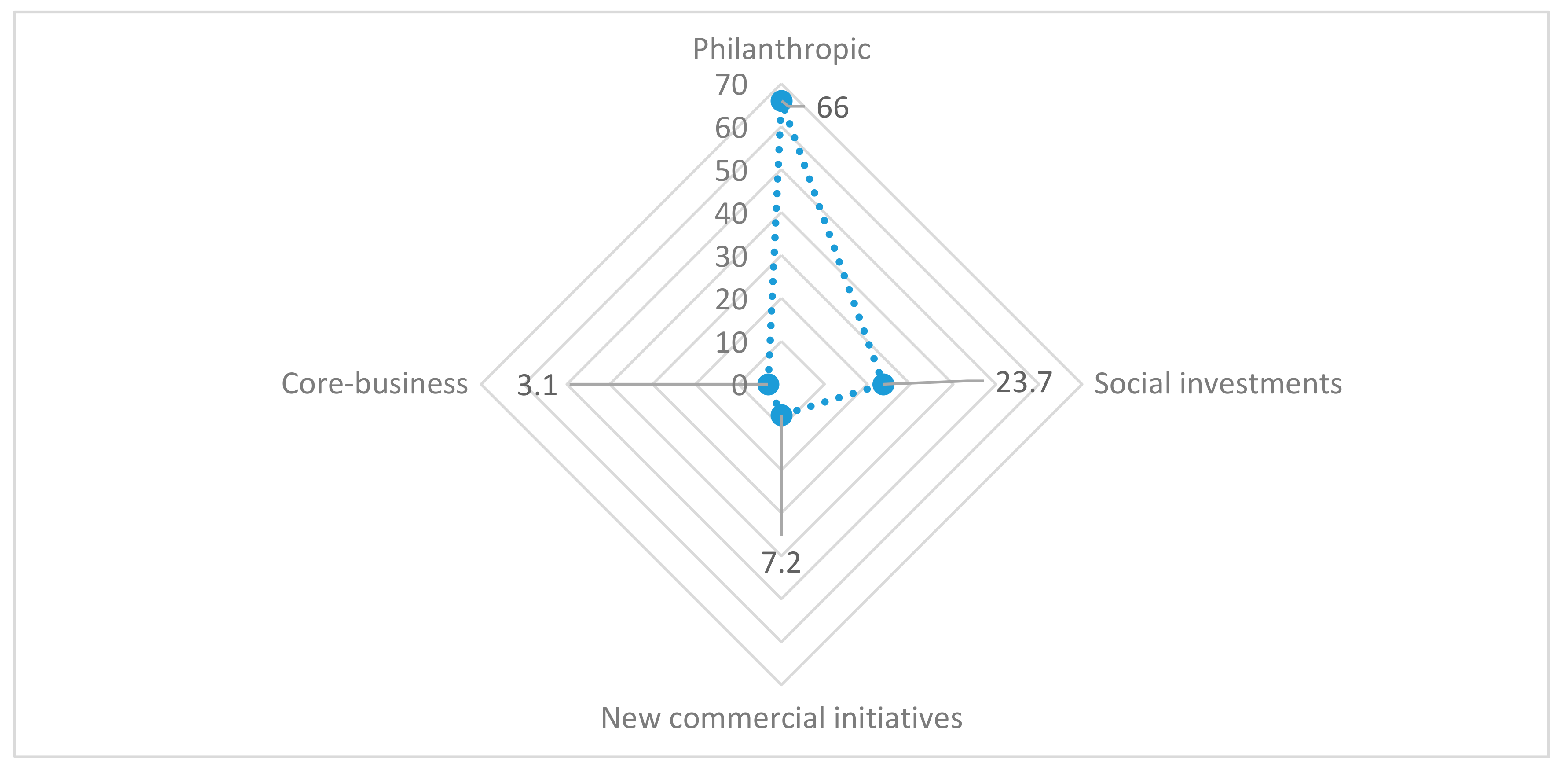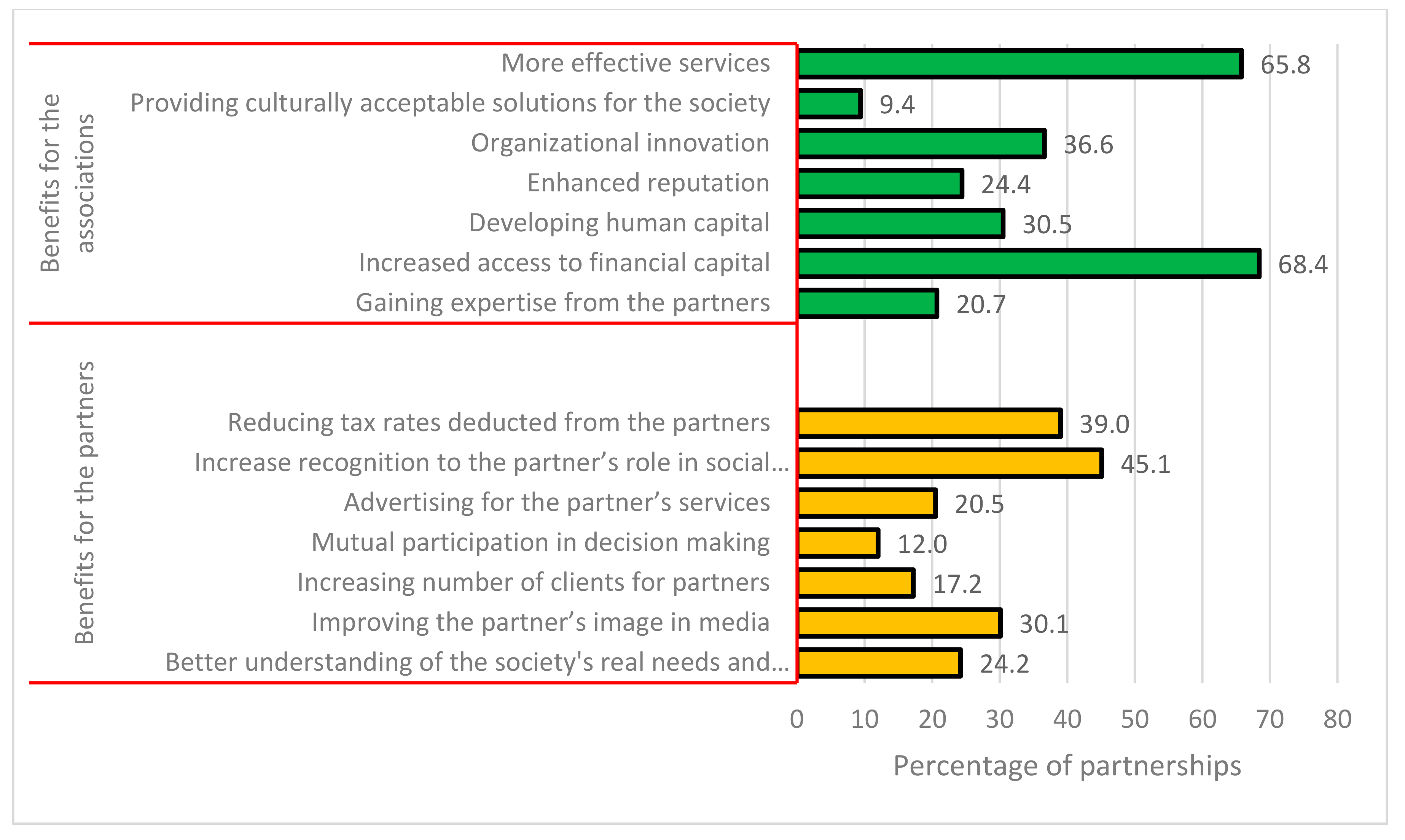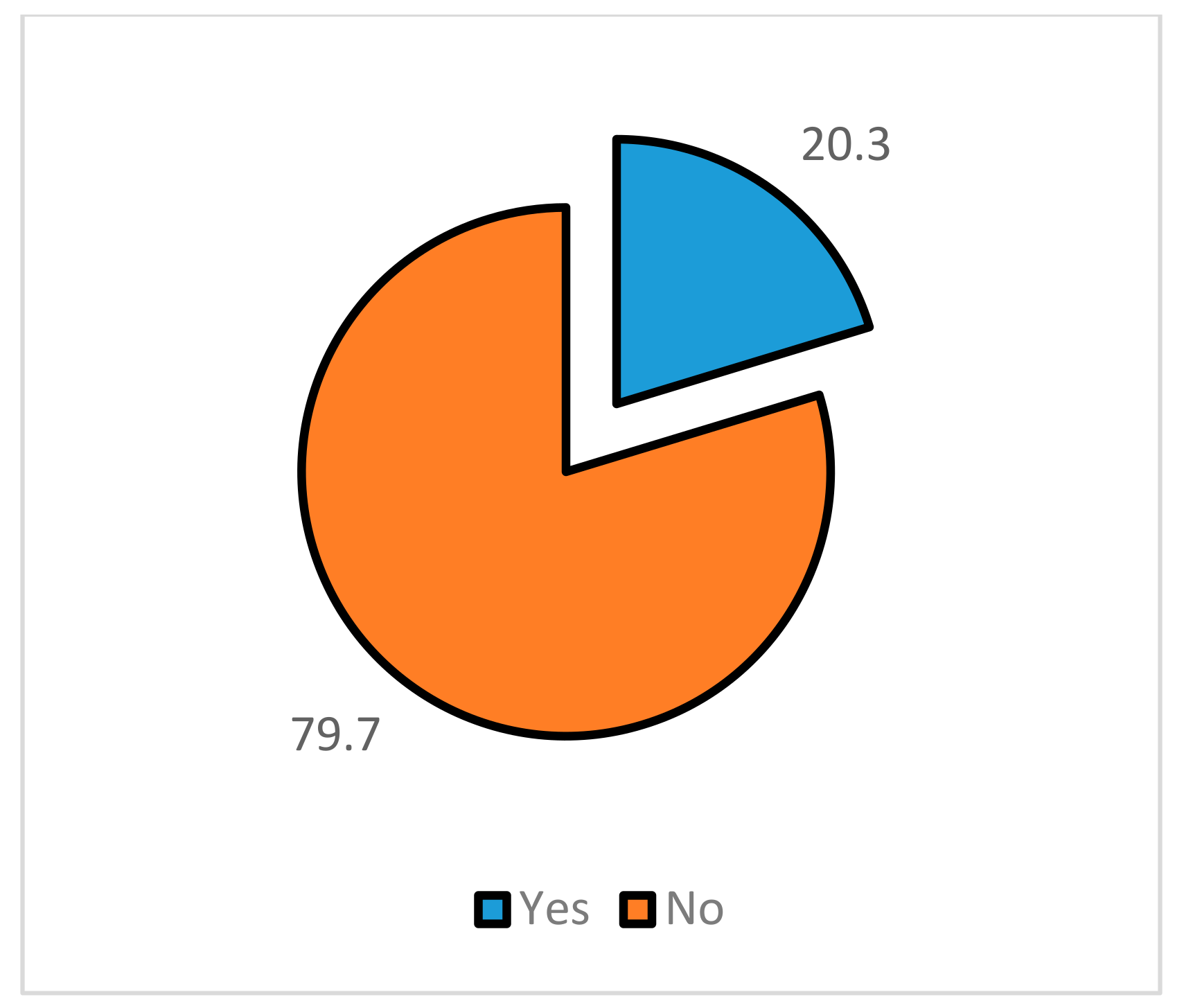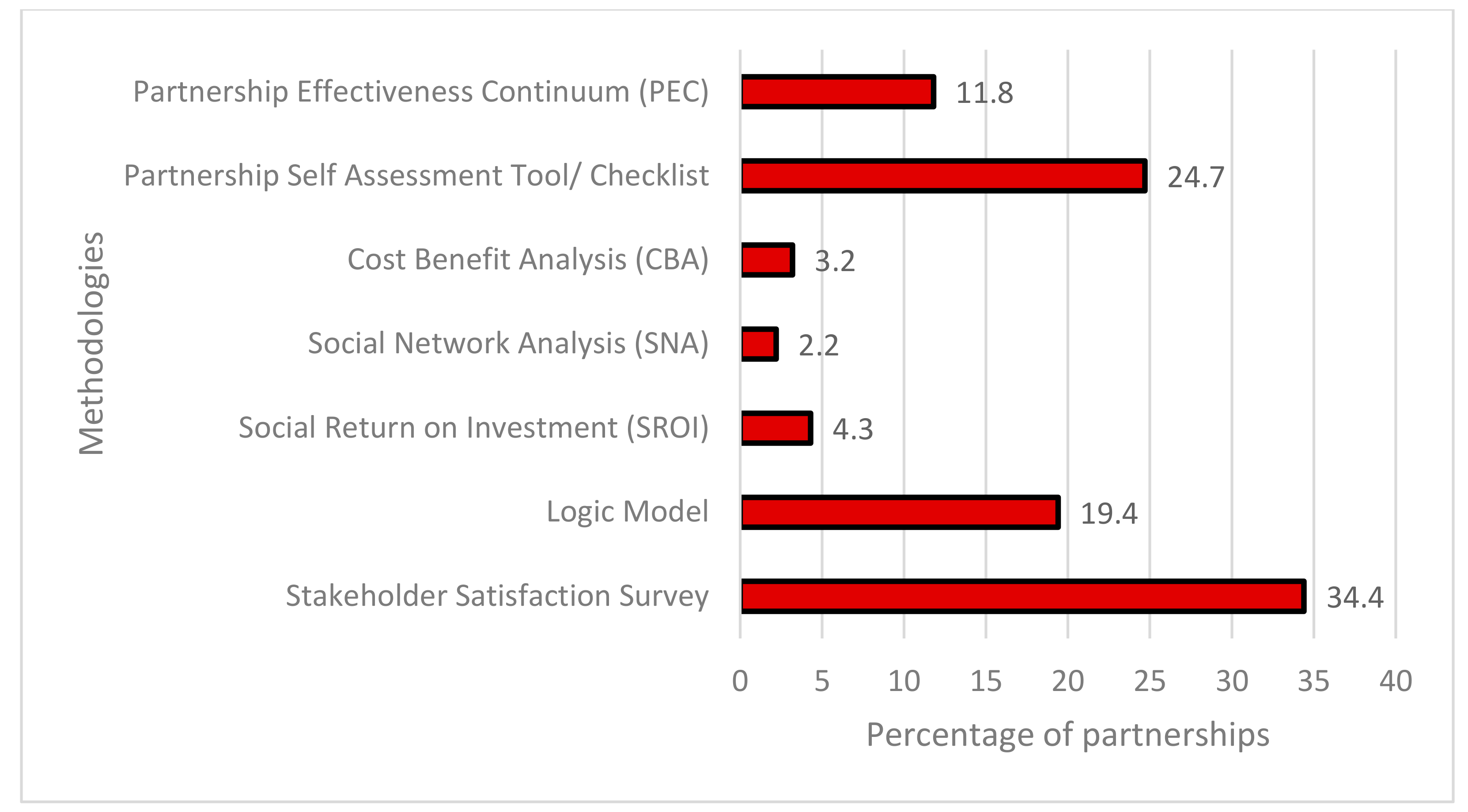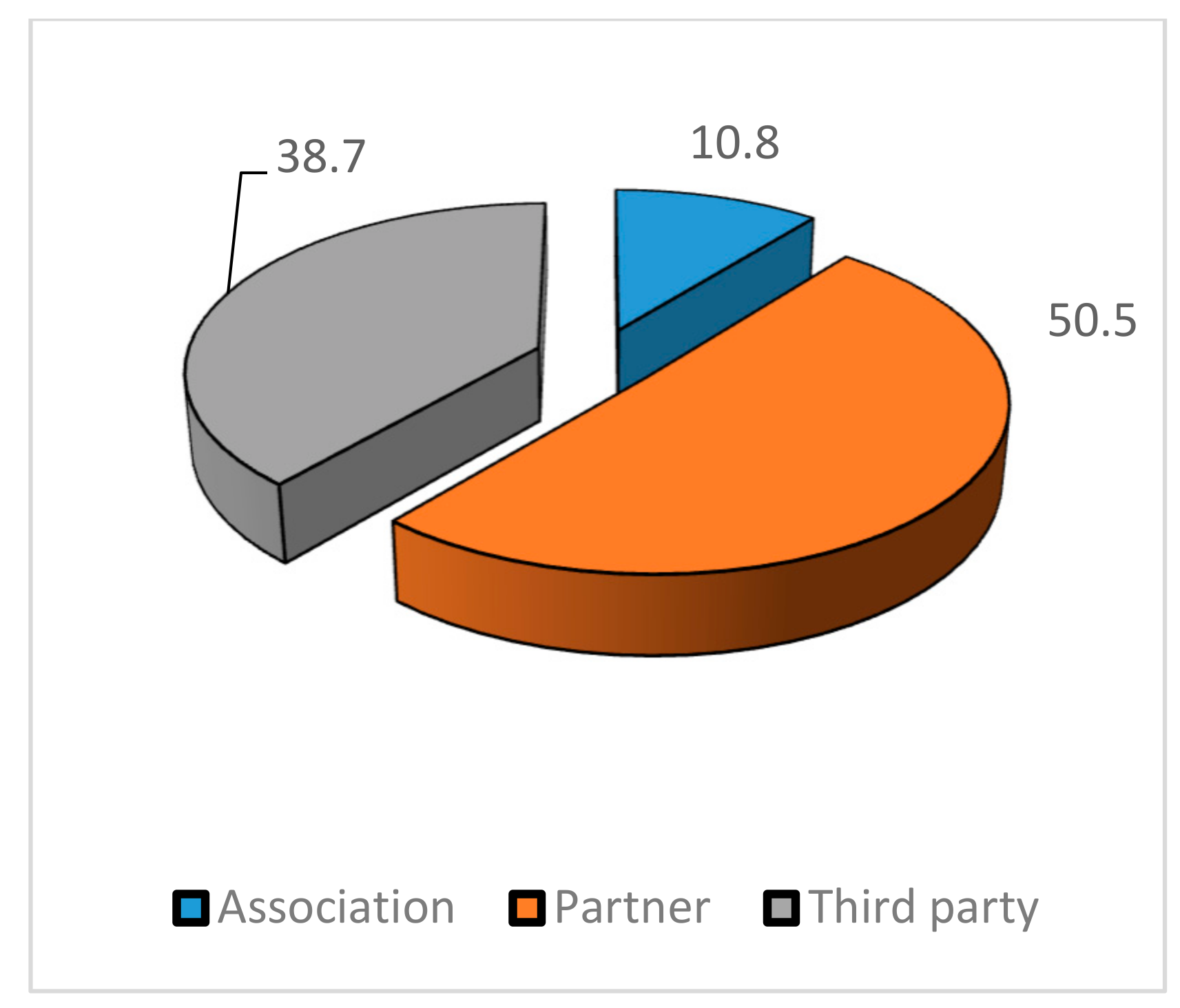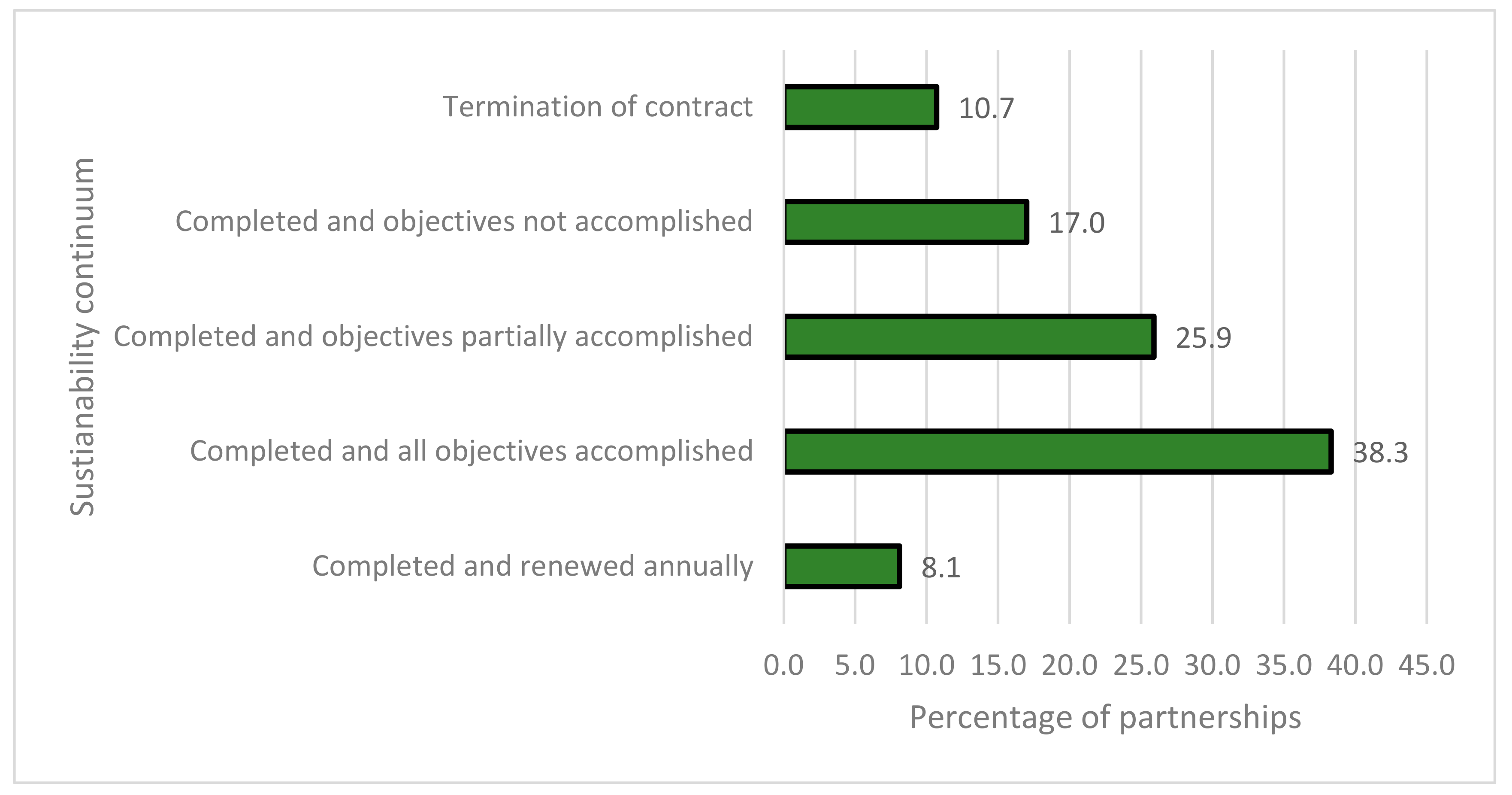1. Introduction
The concept of Sustainable Development gained enormous attention worldwide after the United Nations adopted the Sustainable Development Goals (SDGs) in 2015 [
1]. There are 17 SDGs, which address the economic, social, and environmental aspects of sustainability issues [
2]. Because of the scale and complexity of these issues, the global sustainable development agenda—as formulated in SDGs—emphasizes that the first 16 goals need to be covered by diverse cross-sector partners to explore innovative solutions that effectively address these problems [
3]. In other words, SDG 17, ‘Partnerships for the Goals’, underlines the importance of interactions between actors to foster sustainable development [
4]. The 2030 Agenda refers to two main types of partnerships for implementing the SDGs. First, there is the Global Partnership for Sustainable Development, to be led by governments, which aims to bring together the public sector, the private sector, civil society, the UN system, and other actors to facilitate an intensive global engagement around implementation and mobilizing all available resources [
5]. Second, multi-stakeholder partnerships are a complement to the Global Partnership. Multi-stakeholder partnerships “involve organisations from different societal sectors working together, sharing risks and combining their unique resources and competencies in ways that can generate and maximize value towards shared partnership and individual partner objectives, often through more innovative, more sustainable, more efficient and/ or more systemic approaches” [
6] (p. 1). The aim of these partnerships is to mobilize and share knowledge, expertise, technology, and financial resources to support the implementation of the SDGs [
7].
The United Nations and other international organizations have acknowledged the contribution of Non-Profit Organizations (NPOs) in achieving the SDGs, through specific social, institutional, and technological innovations and practices [
8]. NPOs consist of commercial and noncommercial organizations whose end goals are to improve a community’s wellbeing by providing goods and services rather than maximizing the profits they make [
9]. The core ideology of most NPOs is economic philanthropy—to improve democratic citizenship, social cohesion, and fair trade and to establish a better economy for all [
10]. Nowadays, NPOs play a vital role at both the national and international level in addressing social, economic, and environmental problems, and these organizations also facilitate integration of sustainable development concerns into the decision-making process within both the public and private sectors [
11]. To tackle such problems, NPOs have deployed different strategies by relying on multiple resource providers to pursue other activities furthering the common good and to enable genuine progress in a community [
3,
10].
Since the 1980s, NPOs have undergone remarkable changes in promoting the adoption of business-like approaches [
12]. In this context, Dart [
13] made a first step toward developing the area of NPOs becoming more business-like. He proposes that NPOs can become business-like in any dimension of the following: business-like organization of NPOs’ core, business-like goals, and business-like rhetoric. The first dimension focuses on the concept of business-like at the core, with support processes in NPOs reflecting the belief that organizations can and should be built on corporate management knowledge and practice [
14]. A number of different concepts highlight particular aspects of business-like organizations. Firstly, corporatization refers to changes in the NPO’s governance structure [
15,
16]. Secondly, marketization focuses on NPOs’ market-type relationships with stakeholders or market-type relationships gradually penetrating a country’s welfare system from a macro perspective [
17,
18]. Thirdly, social enterprises focus on undertaking the commercial activities and entrepreneurial behaviors of NPOs that involve high degrees of pro-activeness, risk-taking, and innovation [
19,
20]. Fourthly, the concept of professionalization is also used to describe business-like organizations. This term is generally describing the selection method of personnel [
21]. In other words, more staff with a business management background may be antithetical to business-like practices [
22]. Finally, philanthropy can also be organized in more business-like ways. Venture philanthropy applies venture capitalist methods to philanthropic funding, not just by investing money but also by providing business expertise [
23]. In return, NPOs have high expectations regarding results and accountability [
24]. The second dimension deals with NPOs adopting business-like goals. This most directly refers to the concepts of conversion and commercialization. The term conversion refers to changing of legal status from non-profit to for-profit and shifting control of assets or responsibility for liabilities [
25], whereas commercialization captures NPOs’ increasing reliance on revenue from sales of goods and services [
18]. The third dimension encompasses a set of key concepts that deal with business-like rhetoric, emphasizing some theoretical ideas such as communication, organizational identity, and value frames [
26,
27,
28,
29].
Collaboration in partnerships is one of the effective strategies in motivating businesses to source sustainably so as to improve the community’s social or environmental conditions [
30,
31]. Partnerships have become one of the main issues within business–society relations to achieve sustainability governance [
32,
33]. Therefore, research on sustainability-oriented partnerships has received a considerable amount of attention since the 1990s, both in the social [
34,
35] and the environmental sustainability domains [
36,
37,
38,
39]. Partnerships between private, public, and NPOs are defined in multiple ways. Nevidjon [
40] defines partnerships as “pooling of joint resources (financial, natural, and human), knowledge, skills to create added value”. However, a more holistic definition of partnerships is “collaborative arrangements of joint resources and competencies in which two or more actors are involved in a non-hierarchical process through which these actors pursue common goals” [
41]. According to Ferraro et al. [
42] and George et al. [
43], partnerships have emerged as a new paradigm for strategy across the different sectors to solve complex sustainability challenges through collaboration. The five clusters of partnership characteristics are as follows: producing outcomes that contribute to the creation of public value; sharing resources, practical knowledge, and cultural values between partners; enhanced access to funding; attainment of common goals for mutual benefits; contractual, structured binding agreements; organizational mission fulfillment [
40,
44]. Understanding such characteristics in practice requires analyzing the framework of the partnership in terms of (1) form and focus, (2) nature and types of partnerships involved, (3) organizing and acting, (4) governance structure, and (5) sustaining outcomes [
45].
In Saudi Arabia, NPOs were represented in four kinds of leading organizations: charities, cooperatives, foundations, and endowments [
46]. According to the Ministry of Labor and Social Development [
47], the number of NPOs rose by 131% from 2011 (1125) to 2018 (2598), including their revenues (7.8%), expenses (8.3%), and assets (10.2%). Despite the increased number of NPOs, their performance has been inadequate, and they tend to be weak and governed by traditional management practices. This weakness results in the following: a less than 1% share of GDP; a lower rate of outreach (1:43,000); a decline of volunteer involvement in their activities; a limited scale of professionalism and effectiveness; focusing on “charity” instead of social development; and a lower rate of employment contribution [
48]. According to Altuwaijri [
49], the majority of NPOs had been faced with different challenges, including an aligning mission, methods, and resources; earning public trust and creating awareness of the significance of NPOs; balancing individual interest and the common good; moving beyond charity to systemic change; lack of funding; networking with the private sector; institutionalizing the internal functions and structures. From 2010 to 2018, NPOs have adopted a large number of partnerships with other sectors to promote economic growth, developing their internal capabilities, capitalizing on new opportunities or addressing complex problems, and fostering local ownership for sustainability [
50].
Despite several studies examining different areas of partnerships between NPOs and other actors, most research has focused on the company’s perspective and university–business partnerships. Limited research has attempted to map and analyze the nature and impact of the partnerships implemented and the various roles in collaborative settings, in particular, within a Saudi context. In the present paper, we aim to provide a holistic understanding of this topic to try to cover this gap by mapping and analyzing the partnerships implemented between charitable associations and other sectors. The results gained from this study will support the fourth theme of the Saudi National Transformation Program 2020 as part of its Vision 2030 (Social Empowerment and Non-Profit Sector Development) and its strategic objectives: support NPOs growth, enable NPOs to achieve a more profound impact, and empower social development work [
51]. Furthermore, this study makes a unique contribution to the literature by presenting the internal and external factors that create conditions for collaboration, clarifying how public and private actors seek to engage with NPOs for sustainability, results gained, and where policy gaps remain.
5. Discussion
The literature on the role of NPOs in sustainable development points to the increasing linkages between development cooperation actors and NPOs. However, very few studies have systematically examined how the roles of NPOs differ across various actors. Thus, our picture of NPOs involvement in development is incomplete. The present study makes a unique contribution to the literature by mapping engagement between NPOs and other actors for sustainable development. It builds on the existing literature and analytical framework in order to conduct a systematic examination of 459 partnerships established between the charitable associations and the other actors in the study area.
Our results confirmed the role of the Saudi government through Vision 2030 in supporting partnerships between NPOs and other actors. Developing a conducive environment for partnerships can help in the implementation of policies and contribute toward the achievement of the sustainable development agenda [
101]. In the light of Saudi Vision 2030 and the objectives set by the National Transformation Program 2020 [
50], the government aims to empower NPOs in providing social services through implementing development initiatives and to improve the contribution of NPOs in GDP from less than 1% to 5%, by 2030. International success stories around this issue confirm that building partnerships play a significant role in solving many constraints faced by NPOs. In other words, the sum is greater than the individual parts [
102].
The study’s findings showed that partnerships in the Saudi Arabian context aimed to target various stakeholders, which, in turn, demonstrates the linkages between SDG 17—Partnerships for the Goals and some of the other more specific SDGs. In this context, the results suggest that partnerships between NPOs and other actors facilitate the design and implementation of programs that eradicate poverty in rural and urban areas (SDG 1). Partnerships also facilitate access to markets, natural resources, credit, information, and social protection by providing food for smallholders and ensuring sustainable livelihoods for all, including women, youth, and children (SDG 2). It was also noticed from the results that health services attract the attention of potential partners to engage in collaborations. Full access to affordable, quality health services and psychosocial support for all vulnerable populations have high potential to accelerate progress for SDG 3—Good Health and Well-being. As mentioned in our findings, the cases of women—widows, divorcees, and victims of domestic violence—were addressed in 38.1% of the partnerships, and such collaborations have the potential to enable the mainstreaming of gender equality and empowering of all women and girls (SDG 5). The successful implementation of SDG 5 is also key to the 2030 Agenda, which aims to eradicate poverty and enhance prosperity, as well as promote healthy ecosystems and peaceful societies [
4]. The study’s findings also highlighted the importance of improving the financial stability of NPOs, with leveraging resources being the most important motives in most of the partnerships. Attracting private sector finance for infrastructure development is critical for economic and social development, improving environmental sustainability, reducing poverty and inequality, and ensuring decent work for all (SDG 9) [
31]. Generally, it was concluded that SDG 17—Partnerships for the Goals, should empower NPOs to implement the other SDGs through collaboration with other actors, in order to create value for nature and society by sharing knowledge, expertise, technology, and financial resources [
103].
A relevant framework for identifying value creation in partnerships is offered by Austin and Seitanidi [
90]. Collaborative work between the actors is expected to create four different types of value: associational value, transferred resource value, interaction value, and synergistic value. Associational value is defined as “a derived benefit accruing to another partner simply from having a collaborative relationship with the other organization” [
90] (p. 730); transferred resource value as a “benefit derived by a partner from the receipt of a resource from the other partner [
90] (p. 731); interaction value as “the intangibles that derive from the processes of partners working together” [
90] (p. 731); and synergistic value as “value that arises from the underlying premise of all collaborations that combining partners’ resources enables them to accomplish more together than they could have separately” [
90] (p. 731).
The findings on the drivers of the partnerships confirmed that most associations recognized the importance of CSR for corporation actors as a tool to enhance their reputation and legitimacy. Smart organizations nowadays understand that CSR activities are oriented toward building and renewing natural, social, and human capital as value-creation opportunities for sustainability [
104]. As indicated by Poret [
105], increasing the engagement of corporations with NPOs in CSR activities is not only an altruistic strategy. These organizations have networks along with knowledge, experience, skills, and resources in the societal issues that firms and other actors face. Therefore, for a more practical purpose, selecting the right partner and establishing a coordination committee between partners before a partnership engagement are absolutely critical steps to the success of a CSR strategy [
31]. In this context, Fontana [
106] identified the urgent need for an informed view of charitable organizations’ expectations before initiating collaboration. This view included determining whether charities’ resources allow the partner to improve its CSR efforts at present and in the future, as well as whether collaboration by charities has the potential to become long-term [
105]. Undoubtedly, the extent to which charities and other actors find compromise should be based on the balance between mission integrity and CSR outcomes, which may require performing forecasting metrics [
107].
The results reported that acquiring financial resources is one of the most crucial motives for charitable associations to engage in partnering. Moreover, obtaining funds is considered as an exclusion criterion for potential partners. In the literature, the charities are pro-socially motivated. In other words, they are concentrated on their activities to produce a public good [
108,
109]. This orientation forces these organizations to find new sources of funding to achieve their mission [
110]. However, focusing only on obtaining funds may produce a mismatch within the partnership and may lead to difficulties in working together [
32]. In fact, most actors, in particular, private sector actors, are mainly concerned with strategic partnerships that could maximize long-term mutual benefit [
78]. Hence, the charitable association should change its strategy from being donation-oriented toward leveraging complementary resources in order to use a partnership as a source of competitive advantage [
31].
The study’s findings also revealed significant private sector engagement in the majority of the partnerships investigated. In recent years, governments worldwide have given special attention to expanding the involvement of the private sector to achieve SDGs [
111]. Such a trend goes beyond the traditional impacts of the private sector in development, such as the provision of goods and services, job creation, and economic growth [
112]. This important shift changes the role of the private sector into that of a key partner for using market-based approaches to generate sustainable change [
30]. Nevertheless, the engagement between NPOs and private actors may have the potential to facilitate joint problem solving and turn divergent interests into new sources of innovation [
113].
Our results also showed that philanthropic partnerships are more common in the majority of the partnerships. This conclusion is supported by our findings that higher numbers of engagements involve transfers of financial resources rather than technical cooperation, capacity development, and entrepreneurship. This result may explain why only 8% of the partnerships examined are renewed after completion. Furthermore, not all partnerships are designed to be ‘sustained’ forever. Many partnerships are purposefully designed to be short-term projects. Just because they are terminated, it may not mean they were not successful, and the termination does not necessarily signal that “they did not accomplish the planned objectives”. Therefore, determining the size and type of partnership is an issue. As suggested by KPMG [
91], it is important to analyze the partner’s motivation and to identify the “sweet spot” between development goals and business opportunities. Understanding such balance enables NPOs to combine both philanthropic and strategic approaches [
78]; in other words, implement some marketing-oriented activities to improve businesses’ public image and plan to conduct core-business activities [
113]. This transformation empowers NPOs to achieve their objectives effectively and benefit from such investments as sustainable finance for their activities [
52].
The results demonstrated that systematic evaluation is rarely conducted to measure the impacts of the partnerships implemented. Moreover, among the evaluation tools used, a small number of partnerships used tools for measuring the impacts such as logic model and SROI. On the basis of the official documents analyzed, it was observed that associations only provide general information on the number of partnerships or the expected results of their partnership initiatives, but it seems that relatively little has been done to monitor and evaluate partnership processes and outcomes. This may be attributed to a lack of employee skills and experience required to professionally conduct such frameworks and to the weak awareness of the importance of conducting an evaluation for the partnerships or how partners can benefit from the results of the assessment in the future. According to Rieker [
100], application of evaluation methodologies allows individuals and organizations to access consolidated information that indicates a partnership’s progress, increased experience, and knowledge; reveals mistakes; contributes to transparency and accountability; and offers paths for learning and improvement. This information gap allows an assessment of whether cross-sector partnerships are effective. However, the application of evaluation tools and frameworks would help generate systematized evidence on the relationships between engagement of NPOs and improved outcomes [
113].
Some limitations should be acknowledged. First, we collected data from the Riyadh region in the center of Saudi Arabia, so we could not generalize the results to other regions or other countries. In other words, these results are from the Saudi context only, and in other contexts, the results would differ. Second, our analysis focuses only on charitable associations. This may lead to an inability to present a full picture of the sustainability-oriented partnerships across different kinds of NPOs. Third, the research was designed to collect data about organizations from only the association perspective, without considering the view of other partners. Thus, this approach could bias the results of the current situation of the partnerships investigated. Although our analytical framework covers various areas regarding a partnership’s description, one critical point, such as the area of governance structure, was not addressed. This could affect our understanding of how the governance model supports a partnership’s operation, including decision-making, accountability, and regulatory compliance.
6. Conclusions
The present study investigated the partnerships established between charitable associations and development cooperation actors in Saudi Arabia. As there has been limited literature on this topic in the context of Saudi Arabia, this study contributes to the existing body of knowledge in the field of sustainability-oriented partnerships, by highlighting four main areas: drivers, motivations, characteristics of the partnerships, and outcomes achieved. The results suggest that partnerships established by NPOs have the potential to play a key role in achieving the SDGs by optimizing the use of mutual resources in ways that can, together, achieve more impact, greater sustainability, and increased value to all partners. We found that, despite the impressive number of partnership agreements signed during 2016–2018, only 10.3% of the engagements are characterized as strategic partnerships. Moreover, only 8.1% of these partnerships were renewed after completion. The findings also showed that financial stability was the key motivator for corporations. It was also found that leveraging non-financial resources, and awareness of cultural issues, knowledge, and skills, attracted actors to engage with charitable associations in partnerships. Limited evidence about the social impacts of the partnerships was recognized because the evaluation tools and frameworks did not apply to the majority of the partnerships. The findings provide useful directions and implications for policy-makers. Private sector actors should establish organizational strategies for NPOs’ engagement, informed by their needs and activities, to leverage resources and support in a more complementary fashion. Furthermore, it is important to clearly articulate policy frameworks that guide development cooperation actors with NPOs, including objectives, institutional and legal forms, and expected outcomes. Such actions will help with demonstrating transparency in actors’ engagements, as well as with ensuring accountability for outcomes. Additionally, entrepreneurship activities should be included as important modalities for engaging NPOs in sustainable development. Therefore, strategic efforts to encourage such activities might present new opportunities for maximizing outcomes. Finally, there is an urgent need to improve the availability of monitoring and evaluation results on engagements with NPOs. Efforts are needed to develop and implement more rigorous methodologies that systematically assess the value of engagements. Implementing such methodologies can improve the accuracy of information, build confidence that these partnerships can support positive development outcomes, and encourage future collaborative efforts. A number of essential areas for future research arise from this study. Further research could look at different types of NPOs. There is a need for detailed review of actual partnerships to assess which NPOs are benefiting from engagement with other actors. In a related vein, research on the effectiveness of the governance model adopted in cases of engagement between NPOs and other actors is critical. Such studies generate a better understanding of the relationship dynamics between actors and what constitutes successful engagement. Furthermore, investigating context-specific obstacles for NPOs engagements should also be highlighted.
